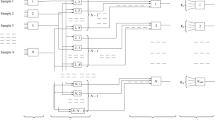Abstract
Recognition of hand drawn shapes is beneficial in drawing packages and automated sketch entry in handheld computers. In this paper, we propose a new approach to on-line geometric shape recognition with incremental training function, which utilizes a heuristic function to reduce noise and a neural network for classification and on-line training. Instead of recognizing segments of a drawing and then performing syntactical analysis to match with a predefined shape, which is weak in terms of generalization and dealing with noise, we examine the shape as a whole. The main concept of the recognition method is derived from the fact that internal angles are very important in the perceived shape of outlines. Our application's aim is to recognize elliptic, rectangular, and triangular shapes in a way similar to human cognition of these shapes. Human beings recognize such basic shapes regardless of the variations in size, noise on the shape border, rotation and in the case of triangles, regardless of the type of the triangle. The key concept is that the neural network learns the relationships between the internal angles of a shape and its classification, therefore only a few training samples which represent the class of the shape are sufficient. Fast meremental training, which is performed on-line, is accomplished by the use of the Binary Synaptic Weights algorithm, a one pass, feedforward neural network training algorithm. Incremental training offers the advantage of adjusting the recognition capability of the system to the user's drawings. the results are very successful, such that the neural network correctly classified shapes that did not have any resemblance to the shapes in the initial training set.
Similar content being viewed by others
References
H.M.A. Andree et al., “A comparison study of binary feedforward neural networks and digital circuits’, Neural Networks, vol. 6, pp. 785–790, 1993.
I. Guyon et al., “Design of a neural network character recognizer for a touch terminal”, Pattern Recognition, vol. 24, no. 2, pp. 105–119, 1991.
R.L. Kahsyap and R. Chellappa, “Stochastic models for closed boundary analysis: Representation and reconstruction”, IEEE Transactions on Information Theory, vol. IT-27, no. 5, pp. 627–637, September 1981.
J. Mantas, “Methodologies in pattern recognition and image analysis—A brief survey”, Pattern Recognition, vol. 20, no. 1, pp. 1–6, 1987.
T. Pavlidis, “Survey: A review of algorithms for shape analysis”, Computer Graphics and Image Processing, vol. 7, pp. 243–258, 1978.
B.K. Ray and K.S. Ray, “Determination of optimal polygon from digital curve using L1 norm”, Pattern Recognition, vol. 26, no. 4, pp. 505–509, 1993.
C.C. Tappert et al., “The state of the art in on-line handwriting recognition”, Transactions on Pattern Analysis and Machine Intelligence, vol. 12, no. 8, pp. 787–708, August 1990.
F. Ulgen and N. Akamatsu, “A fast algrithm with a guarantee to learn: Binary synaptic weights algorithm on neural networks,” Proceedings of SIMTEC'92, Houston, Texas, 1992.
Author information
Authors and Affiliations
Rights and permissions
About this article
Cite this article
Ulgen, F., Flavell, A. & Akamatsu, N. On-Line Shape recognition with incremental training using binary synaptic weights algorithm. Appl Intell 6, 225–240 (1996). https://doi.org/10.1007/BF00126628
Issue Date:
DOI: https://doi.org/10.1007/BF00126628




